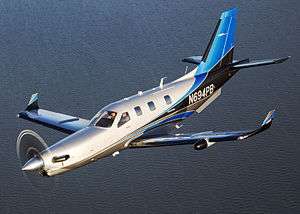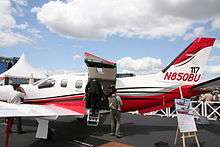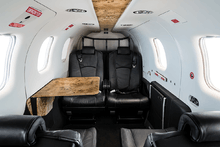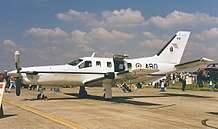SOCATA TBM
| TBM 700 / TBM 850 / TBM 900 TBM 910 / TBM 930 | |
|---|---|
 | |
| A TBM 900 over Lake Winnebago during the 2015 EAA AirVenture Oshkosh event. | |
| Role | Executive transport and civil utility |
| National origin | France |
| Manufacturer | Daher |
| First flight | 14 July 1988 |
| Introduction | 1990 |
| Status | In production |
| Primary users | French Army French Air Force |
| Produced | 1988–present |
| Number built | 900 (As of July 2018)[1] |
| Unit cost | |
The SOCATA TBM 700 (also marketed as the TBM 850, Daher TBM 900, Daher TBM 910 and Daher TBM 930) is a high performance single-engine turboprop light business and utility aircraft manufactured by Daher. It was originally collaboratively developed between the American Mooney Airplane Company and French light aircraft manufacturer SOCATA.
The design of the TBM family originates from the Mooney 301, a comparatively low-powered and smaller prototype Mooney developed in the early 1980s. Following Mooney's acquisition by French owners, Mooney and SOCATA held a series of in-depth discussions on the potential for co-developing a new enlarged turboprop design derived from the earlier 301; these resulted in the formation of a joint venture for the purpose of developing and manufacturing the envisioned aircraft, which was designated as the TBM 700. From the onset, emphasis was placed upon the design's speed, altitude, and reliability. Upon its entry onto the market in 1990, it held the distinction of being the first high-performance single-engine passenger/cargo aircraft to enter production.[3]
Shortly after launch, the TBM 700 was a market success, which quickly led to the production of multiple variants and improved models, often incorporating more powerful engines and new avionics, amongst other features. The TBM 850 is the production name assigned to the TBM 700N, an improved version of the aircraft powered by a single Pratt & Whitney PT6A-66D. In March 2014, an aerodynamically refined version of the TBM 700N, marketed as the TBM 900, was made available.[4]
Design and development
Origins
In the early 1980s, the Mooney Airplane Company of Kerrville, Texas, designed a six-seat pressurised light aircraft, powered by a single 360 hp (268 kW) piston engine, which they designated the Mooney 301. On 7 April 1983, the prototype 301 conducted its maiden flight.[5] During 1985, the Mooney Aircraft Company was acquired by new French owners, who promptly took an interest in the further development of the fledgling 301.[6] Coinciding with the company's acquisition, French light aircraft manufacturer SOCATA, who had identified a vacant market position for a purpose-built optimised single-engine aircraft capable of fast personal transport and light cargo duties, identified the piston-powered 301 as a potential starting point to satisfy this niche.[7]
Accordingly, talks soon commenced between Mooney and SOCATA on the subject of producing a turboprop-powered derivative of the 301.[5] The product that emerged from these discussions was a new design, referred to as the TBM 700, which was considerably heavier than the original 301 while provisioned with more than twice the available power. The prefix of the designation, TBM, originated from the initials "TB" - which stands for Tarbes, the French city in which SOCATA is located - while the "M" stands for Mooney.[5] At the time of its conception, while several aviation companies had studied or were otherwise considering the development of such an aircraft, the envisioned TBM 700 was the first high-performance single-engine passenger/cargo aircraft to enter production.[3] From the onset, key performance criteria were established for the design, demanding a high level of reliability while also being capable of an unequalled speed/altitude combination amongst the TBM 700 other single-engined peers.[8]
%2C_Luxembourg_PP1369480421.jpg)
Consequently, during June 1987, a joint venture, named TBM International, was established with the aim of completing development of the TBM 700 design and to perform the manufacture of the new aircraft; the ownership of the joint venture was divided between Mooney and SOCATA's parent company Aérospatiale.[5][9] A pair of separate production lines for the TBM 700 were planned, one located at Mooney's facility in Kerrville, Texas, which was intended to cater to the American market, and the other based at SOCATA's factory in Tarbes, which was set to produce aircraft for customers throughout the rest of the world.[8] However, during the late 1980s and early 1990s, Mooney was afflicted by persistent fiscal shortfalls; consequently, in May 1991, Mooney chose to withdraw from participation in the joint venture, leaving SOCATA as the primary company involved in the programme.[5]
On 14 July 1988, the first TBM 700 prototype conducted the type's maiden flight.[9][8] Flight testing proved that virtually all of the established goals of the design had been achieved, leading to quick progress towards production. On 31 January 1990, type certification was received from French authorities; it was followed by the awarding of US Federal Aviation Administration (FAA) certification on 28 August 1990.[5] During early 1990, the first delivery of a TBM 700 occurred; the first production batch of 50 aircraft were sold out almost instantly.[8] Early feedback received from operators and pilots was typically positive about the capabilities of the new aircraft, often praising its speed and generous power margins amongst other attributes.[8]
Further development
According to aerospace publication Flying Magazine, while the TBM 700 had rapidly proved popular on the market and a good aircraft on its own merits, the services and support facilities SOCATA provided for the aircraft were an initial point of weakness.[8] Early on, customers were often faced with lengthy delays in acquiring spare parts and other services; negative feedback on the after sales support for the TBM 700 has been attributed as the cause of a downturn in sales during the 1990s. SOCATA, recognising the critical importance of an effective support infrastructure, decided to invest heavily in improving worldwide support for the type; instead of being solely reliant upon third parties and partnership arrangements with other companies, the firm developed their own facilities.[8] SOCATA opened its own service center in Florida, as well as establishing a network of distributors capable of both sales and services for the TBM 700. Consequently, during the late 1990s, sales of the type within the North American market rose dramatically.[8]
Early on, the TBM 700 was available in several different configurations and models. The introduction of the TBM 700C2, which increased the maximum takeoff weight from 6,578 lb to 7,394 lb, enabled operators to fly with both fully laden fuel tanks and maximum cabin occupancy instead of comprising between the two due to weight restrictions.[8] The modifications made upon this model included the addition of a baggage compartment aft of the rear pressure bulkhead, the strengthening of the wing and landing gear, and seat crashworthiness certification for up to 20 G to accommodate for an elevated stall speed at higher weights.[10] Around the same time, SOCATA decided to re-design the interior of the aircraft, both in terms of the fittings and finish, along with the adoption of a new integrated environmental control system, to improve passenger comfort levels.[11]
.jpg)
The TBM 850 is the production name for the TBM 700N, an improved version of the aircraft powered by a single Pratt & Whitney PT6A-66D engine, which is flat rated at 850 shp (634 kW). The TBM 850 is limited to 700 shp (522 kW) for takeoff and landing; however, during cruise flight, the engine power can be increased to 850 shp (634 kW); this extra power provides the aircraft with a higher cruising speed than the TBM 700 models, especially at high altitudes (due to the flat-rating). The outside appearance of the TBM 850 has remained similar as that of the standard TBM 700. The TBM 850 has a typical range of 1,520 nautical miles (2,820 km). Beginning with the 2008 model, the TBM 850 has been equipped with the Garmin G1000 integrated flight deck as standard equipment.[12]
In 2014, an improved version of the aircraft, marketed as the TBM 900 was introduced, featuring 26 individual modifications, including the adoption of in-house-designed winglets, a redesigned air intake and the fitting of a five-blade Hartzell-built propeller, orientated around delivering improved aerodynamics and performance.[13] The adoption of a sharp strake, located forward and beneath the leading edge of the left wing, also provides for improved stall characteristics over the earlier TBM variants. According to aircraft publication Aviation Week, various subtle exterior changes were made for drag reduction purposes, including the addition of inner main landing gear doors, the re-contouring of the tail cone and of the engine nacelle.[14]
In comparison with the TBM 850, the TBM 900 is around 14 kt faster in cruise flight, uses less fuel, requires less runway length, climbs faster, and produces noticeably less interior and exterior noise alike.[14] This is partially due to the elimination of the 700-shp limitation for takeoff present on previous TBM models; all 850 shp of the PT6A-66D engine is normally available. In combination with a more efficient air inlet, which boosted the available torque and ram recovery, and reshaped exhaust stacks, which increased thrust output, makes the plane faster. According to Aviation Week, due to its greater speed, the TBM 900 can more effectively compete against light jets. They observed that it is faster on a 600-nm mission, and burns 26 per cent less fuel than the Cessna Citation Mustang.[14]
At the June 2018 Eurosatory, an ISR configuration with underwing hardpoints and electrical connections for sensors and aerial photography was offered for defense, security, medical evacuation and transport missions. Competing with heavier aircraft and MALE UAVs, it benefits from its short field performance and speed, offers six hours of surveillance and can be reconfigured for other duties. It was validated with a 110-pound (50-kg) camera and a multi-sensor optronics retractable turret, SAR/ground MTI radar, communication interception system, and secure transmission with a quick-change console for tactical situation monitoring.[15]
Design
.jpg)
The SOCATA TBM is a single-engined turboprop-powered low-wing monoplane, capable of seating a maximum of seven people. It is composed mainly of aluminium and steel construction, but with the tail surfaces built of Nomex honeycomb. The wing features a very effective Fowler flap, comprising 80 per cent of the trailing edge's span, for the purpose of lowering the aircraft's stall speed.[11] The TBM 700 is outfitted with a retractable tricycle landing gear arrangement, newer models feature stronger main landing gear wheels and tougher tyres.[16][5][17] The TBM 900 model features automatic torque limiting for “set and forget” power management, which is of particularly use during takeoffs; according to Aviation Week, while this function does reduce the high workload associated with managing the PT6A engine, it is not as capable as a full FADEC arrangement.[14]
The cockpit design of the TBM strives to be user-friendly and as uncomplicated to operate as possible.[11] For pilot convenience, an automatic fuel selector automatically switches between fuel tanks periodically to effortlessly maintain fuel balance throughout flight; manual selection of fuel tanks is also possible, which remains overseen by a low fuel warning system.[11] The ice protection system is as automated as possible, the windshield being electrically heated, the air inlet being kept warm by engine exhaust and the de-ice boots automatically cycling once activated. The electrically actuated flaps are monitored by a sophisticated split-flap protection system to prevent asymmetric deployment.[18] An onboard air data computer calculates various values to support the pilot, such as the aircraft's true air speed, wind, and power advisory notices based upon current external temperature and altitude.[18]
The Pratt & Whitney Canada PT6A-64 engine, providing up to 700 shp (522 kW).[5][17] According to Flying Magazine, the PT6A-64 engine is "the secret to the TBM 700's performance.[18] At sea level, the engine is capable of generating a maximum 1,583 shp, which is intentionally limited to 700 shp on early TBM models; the limit allows the aircraft to maintain 700 shp up to 25,000 ft on a typical day. Engine reliability and expected lifespan are also enhanced by the limitation.[18] While the typical engine overhaul life is set as 3,000 flight hours between overhauls, on-condition servicing can also be performed due to various engine parameters being automatically recorded by the engine trend monitoring (ETM) system. Data from the ETM can be reviewed by the engine manufacturer to determine the level of wear and therefore the need for inspection or overhaul.[18] The ETM, which is connected to the aircraft's air data computer, also provides information to enable easy power management by the pilot.[18]

The cockpit of the TBM seats a pair of flying crew. According to Flying Magazine, even in the standard configuration, the cockpit is provided with a generous suite of avionics and equipment.[18] It features an electronic flight instrument system (EFIS), traffic collision avoidance system (TCAS), terrain awareness and warning system (TAWS), weather radar, lightning detection, dual Garmin GNS 530 navigation/communication systems, Bose headsets, dual transponders, dual compasses, and full cockpit instrumentation for both positions.[18] Pilots can enter the cockpit either from the main cabin or via a small pilot's door on the left hand side, forward of the wing; in a cargo configuration, the pilot's door eliminates the need to clamber over the cargo payload.[18] The pilot's door is an optional extra, and is not installed upon all aircraft. From the TBM 700B onwards, an enlarged cabin entry door was introduced, which later became standard upon subsequent models.[18]
The TBM 900 model features several ergonomic improvements within the cockpit, increasing both simplicity and automation.[14] A new single power lever integrates the power, propeller and condition lever controls. Various switches and controls, such as some formerly present upon the overhead panel, have been eliminated.[14] The electrical system is powered by a single main generator, which is supplemented by a belt-driven alternator.[18] On the TBM 900, electrical load distribution changes enable the Garmin G1000 glass cockpit to power up in sync with the switch-on of the battery with little battery drain. The G1000 also has upgraded displays, including an ISA temperature deviation indication, integrated weather radar and MFD map, and automatic landing field elevation inputs to the pressurization controller.[14]
In a passenger configuration, the pressurised cabin of the TBM is typically fitted with highly finished interiors, often featuring luxury materials such as high quality leathers and wood veneers. The seats are certified for their crashworthiness for up to 20 G.[11] From the TBM 850 onwards, a combined air conditioner/environmental control system was integrated into the cabin, being simpler and requiring less adjustment than the prior arrangement.[11] At cruise altitudes, the cabin of the TBM 900 is noticeably quieter that its predecessors; the reduction is due to the adoption of a new five-bladed propeller and the reduction of vibration levels via greater isolation between the engine and the airframe.[14] Later built models are equipped with winglets, which were developed by SOCATA primarily to reduce drag when flown at high angles of attack, such as during takeoffs, as well as to enhance the aircraft's aesthetics.[14] The TBM 900 saw the adoption of a new five-bladed propeller, specially optimised by Hartzell based upon airflow simulations conducted of the TBM's forward section. According to SOCATA, Hartzell's selection over a similar advanced counterpart from MT-Propeller was made due to the former raising the cruise speed by around 3 to 5 kts.[14]
In October 2017 Daher advertised that the design had a 60 US gal (230 l) fuel burn and US$213-228 maintenance cost per flight hour.[19]
Variants


- TBM 700A
- Initial production version with one Pratt & Whitney Canada PT6A-64 turboprop engine.
- TBM 700B
- Variant with wide entrance door, increased maximum zero fuel weight and other improvements.
- TBM 700C1
- Improved version with rear unpressurised cargo compartment, reinforced structure, new air conditioning system and other improvements.
- TBM 700C2
- C1 with increased maximum takeoff weight.
- TBM 700N
- Initial production name of the TBM 850.
- TBM 850
- Higher-performance version fitted with a Pratt & Whitney Canada PT6A-66D engine, rated at 850 hp in flight (700 hp at take-off).
- TBM 850 G1000
- TBM 850 with a G1000 Integrated Flight Deck and a fuel tank extension modification.
- TBM 850 Elite
- Updated version of the TBM 850, including four cabin seats in a forward-facing configuration, allowing for an increased cargo area aft of the cabin.[20]
- TBM 900
.jpg)
- Improved version of the TBM 850 with various aerodynamic refinements, including winglets and a redesigned induction system.[21] Maximum cruise speed increased to 330 kn at FL310. Range of 1,730 nmi (with 45-minute standard IFR reserves) at 252 kn and 37 gph, or 1,585 nmi at 290 kn.[13] The previously optional Hartzell five-blade carbon fiber propeller is now standard, increasing performance and decreasing cabin noise.
- TBM 910
- New version introduced in April 2017, with the upgraded avionics suite Garmin G1000 NXi.[22]
- TBM 930
New version introduced in April 2016, with upgraded interior and avionics, including the Garmin G3000 touchscreen avionics suite. The TBM 930 is offered alongside the 900 and has not replaced it in the line-up.[23][24]
Production
By June 2018, the TBM fleet had logged a combined 1.6 million flight hours.[15] By July 2018, 900 aircraft had been delivered.[1]
Production (GAMA, as of 31 December 2017):
- TBM 700 - 324 built between 1990 and 2005
- TBM 850 - 338 built between 2006 and 2013
- TBM 900/910/930 - 217 built:
- TBM 900 - 114 built between 2014 and 2016
- TBM 910 - 29 built since 2017
- TBM 930 - 74 built since 2016.
Operators
.jpg)
The aircraft is used by both private individuals, corporations and charter and hire companies.
Military operators
- France
- French Air Force – 15 in service (2016).[25]
- French Army Light Aviation (ALAT) – 8 in service (2016).[25]
Accidents and incidents
On 5 September 2014, a TBM 900 (registered N900KN) was found flying with an apparently unconscious pilot over South Carolina in the eastern United States. Pilots of fighter aircraft that scrambled to trail the TBM 900 observed that the windows were frosted over. The aircraft reportedly crashed in the sea 14 miles northeast of Portland Parish, Jamaica, on the country's northeast coast.[26][27]
Specifications (TBM 900)



Data from TBM[28]
General characteristics
- Crew: one or two pilots
- Capacity: four to six occupants, including pilots
- Payload: 636 kg (1,403 lb) (max)
- Length: 10.736 m (35.22 ft)
- Wingspan: 12.833 m (42.10 ft)
- Height: 4.355 m (14.29 ft)
- Wing area: 18 m² (193.75 sq ft[29])
- Empty weight: 2,097 kg (4,629 lb)
- Max. takeoff weight: 3,353 kg (7,394 lb)
- Usable fuel: 291 US gal. / 1,100 liters
- Powerplant: 1 × Pratt & Whitney Canada PT6A-66D turboprop, 634 kW (850 hp)
Performance
- Maximum speed: 611 km/h (330 knots) FL280
- Cruise speed: 467 km/h (252 knots) Long Range Cruise FL310
- Range: 3,304 km (1,730 nmi) Long Range Cruise FL310
- Service ceiling: 9,450 m (31,000 ft)
- Fuel consumption: 208 l/h (55.0 USG/h), 164 kg/h at 320 kn (590 km/h) TAS, FL310, normal cruise, 6300 lbs (2858 kg)[30]
- Time-to climb to 31,000 ft.: 18 min. 45 sec
See also
Related development
Aircraft of comparable role, configuration and era
References
Citations
- 1 2 "900 deliveries and going strong: A new program achievement for Daher's TBM very fast turboprop aircraft family" (Press release). Daher. July 23, 2018.
- ↑ "Purchase Planning Handbook" (PDF). Business & Commercial Aviation. Aviation Week Network. May 2018.
- 1 2 McClellan April 2003, p. 65.
- ↑ Durden, Rick (12 March 2014). "DAHER-SOCATA Reveals New TBM 900". AVweb. Retrieved 15 March 2014.
- 1 2 3 4 5 6 7 8 Simpson, Rob. "TBM 850: EADS Socata challenges the Very Light Jets". Air International, February 2006, Vol 70 No 2, pp. 28–31. ISSN 0306-5634/, p. 28-29.
- ↑ Taylor 1988, p. 441.
- ↑ McClellan April 2003, pp. 65-66.
- 1 2 3 4 5 6 7 8 9 McClellan April 2003, p. 66.
- 1 2 Taylor 1988, p. 135.
- ↑ McClellan April 2003, pp. 66-67.
- 1 2 3 4 5 6 McClellan April 2003, p. 67.
- ↑ "EADS SOCATA Unveils the 2008 TBM 850" (Press release). Tarbes: Airbus. 17 January 2008. Archived from the original on 2 April 2016. Retrieved 9 March 2008.
- 1 2 "DAHER-SOCATA reveals the TBM 900 very fast turboprop aircraft" (PDF) (Press release). Tarbes: DAHER. 12 March 2014. Archived from the original (PDF) on 16 March 2014.
- 1 2 3 4 5 6 7 8 9 10 George, Fred. "Pilot Report: Daher Socata TBM 900." Aviation Week, 22 May 2014.
- 1 2 "Daher announces the development of a new TBM configuration for intelligence, surveillance and reconnaissance (ISR) missions" (Press release). Daher. June 11, 2018.
- ↑ McClellan April 2003, pp. 66-68.
- 1 2 Jackson 2003, p. 150.
- 1 2 3 4 5 6 7 8 9 10 11 McClellan April 2003, p. 68.
- ↑ "TBM 930 Essential Guide" (PDF). Daher. Oct 2017.
- ↑ Sarsfield, Kate (23 April 2012). "Daher-Socata makes TBM 850 an Elite". Flightglobal. London: Reed Business Information. Retrieved 23 April 2012.
- ↑ J. Mac McClellan (June 2014). "TBM900". Sport Aviation: 76.
- ↑ Bertorelli, Paul (4 April 2016). "Daher Unveils The TBM 910". AVweb. Retrieved 5 April 2017.
- ↑ Grady, Mary (6 April 2016). "Daher Adds TBM 930 To Turboprop Line". AVweb. Retrieved 7 April 2016.
- ↑ Grady, Mary (7 April 2016). "Update: TBM 930 Now On Display At Sun 'n Fun". AVweb. Retrieved 8 April 2016.
- 1 2 Craig Hoyle (2016). "World Air Forces Directory 2017". FlightGlobal.
- ↑ Botelho, Greg. "Pilot of unresponsive plane asked to descend before contact lost". CNN.com. Retrieved 8 September 2014.
- ↑ Whitefield, Mimi; Charles, Jacqueline. "Jamaica finds wreckage of runaway plane". The Miami Herald. Retrieved 8 September 2014.
- ↑ "TBM-900 Specifications & Price list 2016" (PDF). TBM. March 2016.
- ↑ "Top-of-the-line T-prop" (PDF). AOPA Pilot. aircraft owners and pilots association. January 2012.
- ↑ "TBM 910 pilot's operating handbook" (PDF). Daher. January 15, 2017.
Bibliography
- McClellan, J. Mac (April 2003). "TBM 700C2". Flying Magazine. Vol. 130 no. 4. pp. 64–70. ISSN 0015-4806.
- Jackson, Paul. Jane's All The World's Aircraft 2003–2004. Coulsdon, UK: Jane's Information Group, 2003. ISBN 0-7106-2537-5.
- Taylor, John W. R. Jane's All The World's Aircraft 1988–89. Coulsdon, UK: Jane's Defence Data, 1988. ISBN 0-7106-0867-5.
External links
| Wikimedia Commons has media related to: |
- Official website
- "Type Certificate Data Sheet" (PDF). EASA. 25 March 2009.
- Fred George (25 January 2017). "Pilot Report: Daher's New TBM 930". Business & Commercial Aviation. Aviation Week.
- "The TBM Book" (PDF). Daher. Oct 2017.